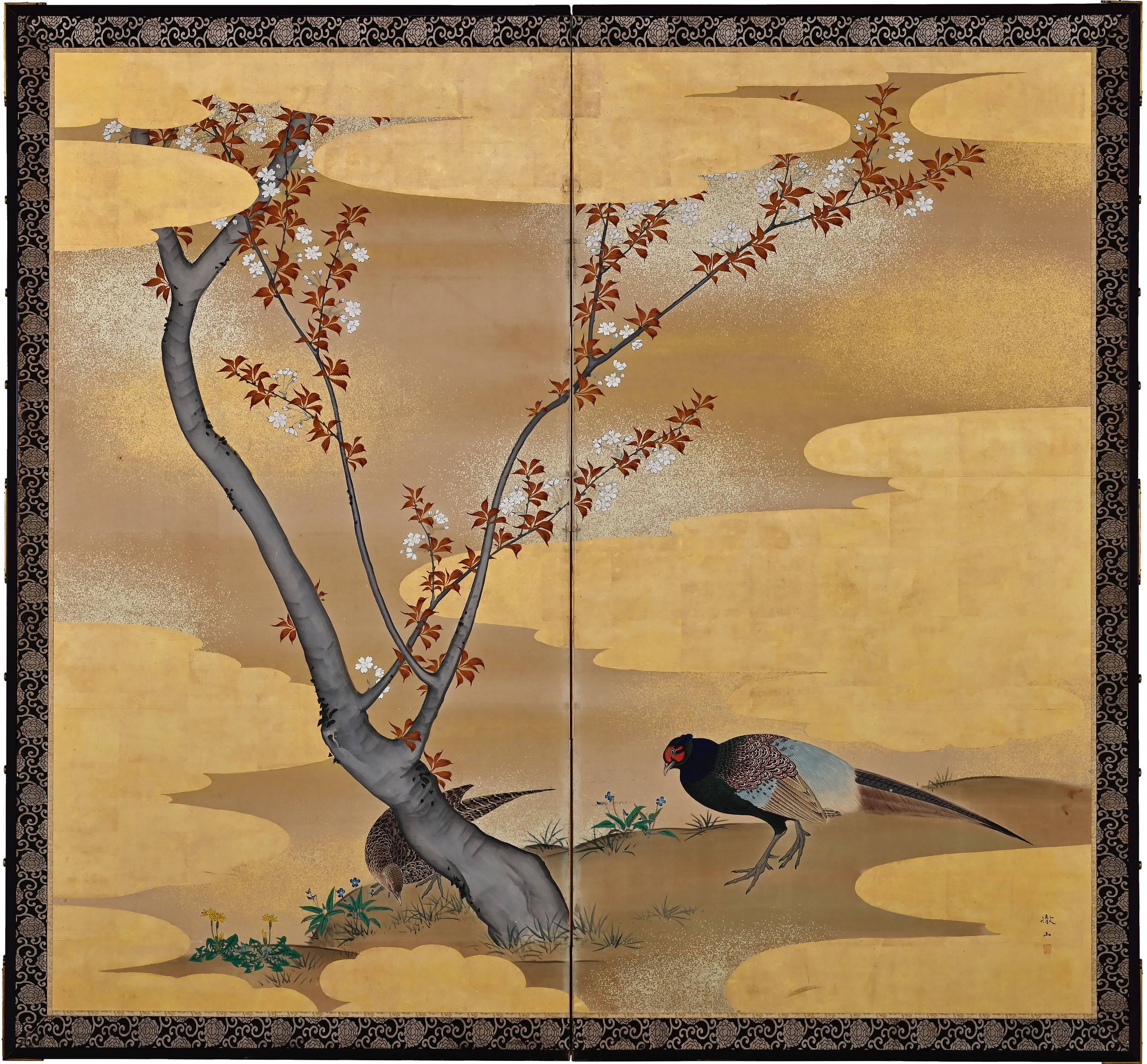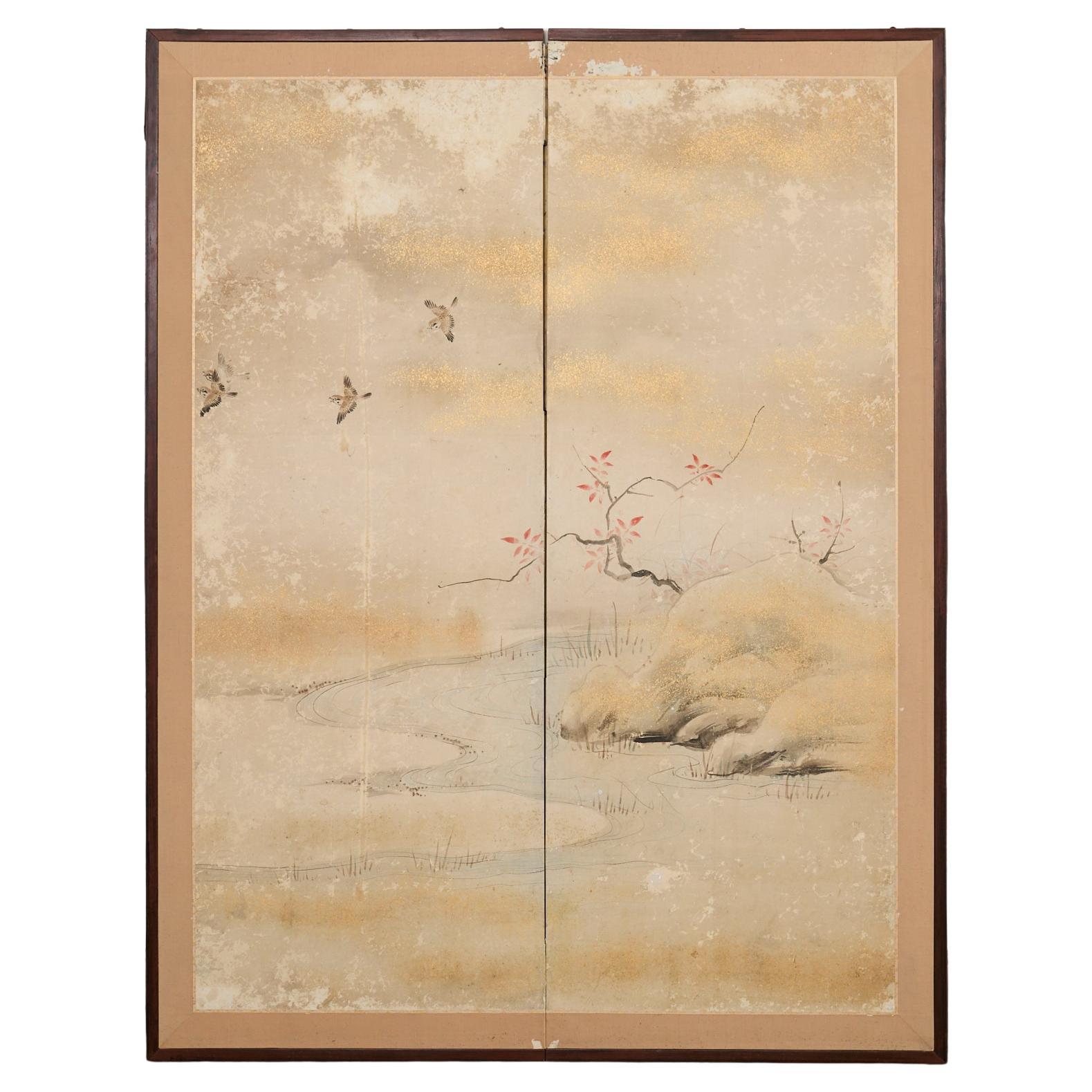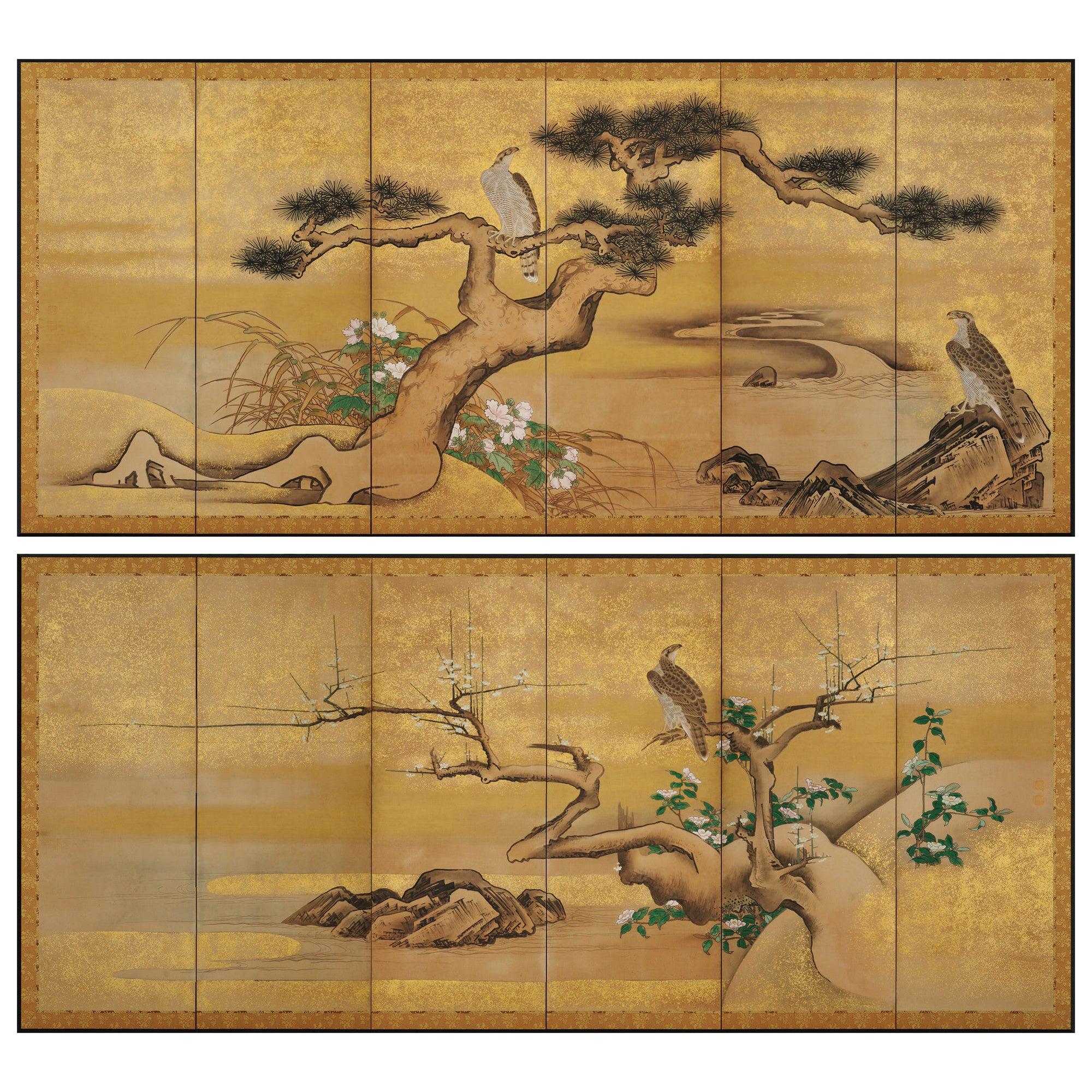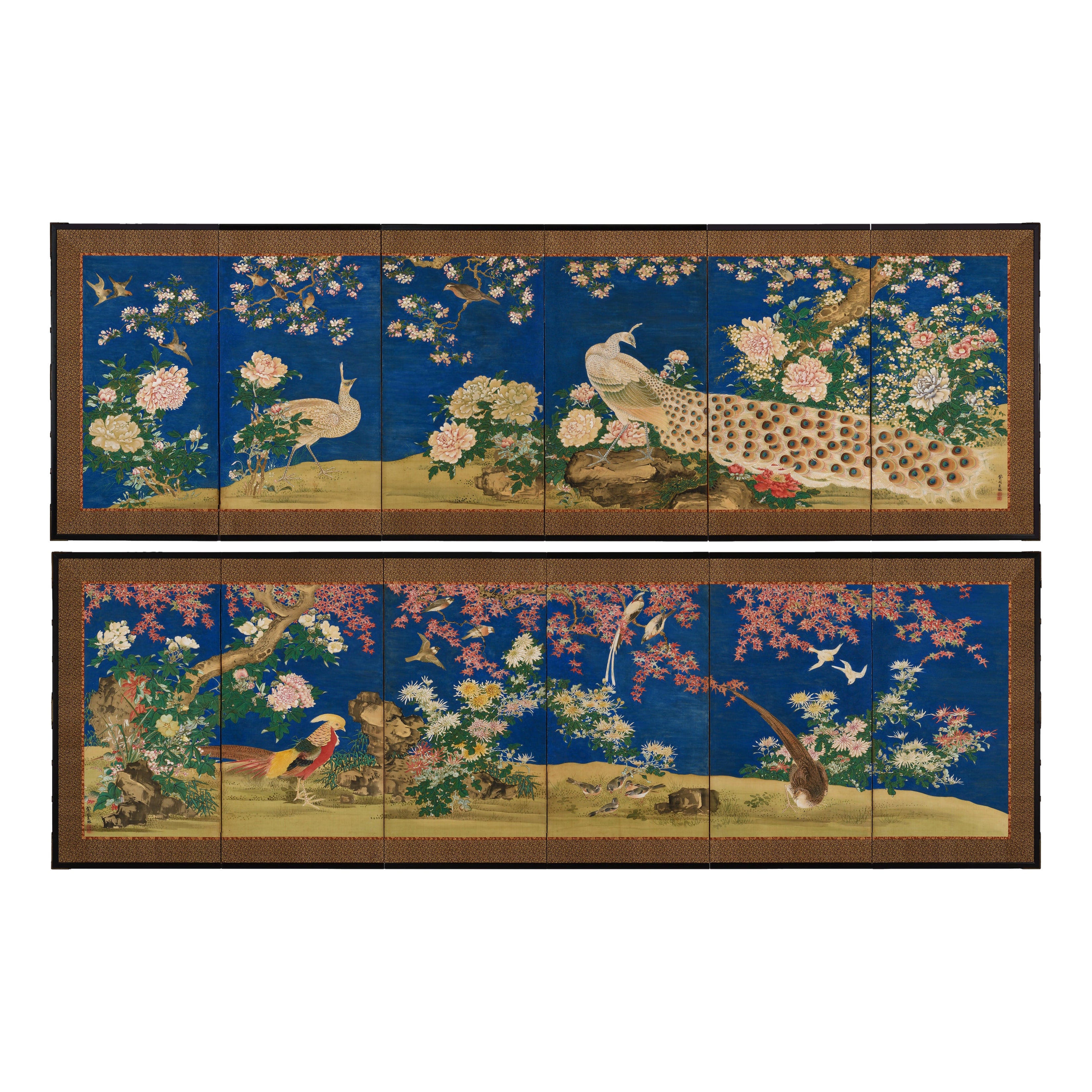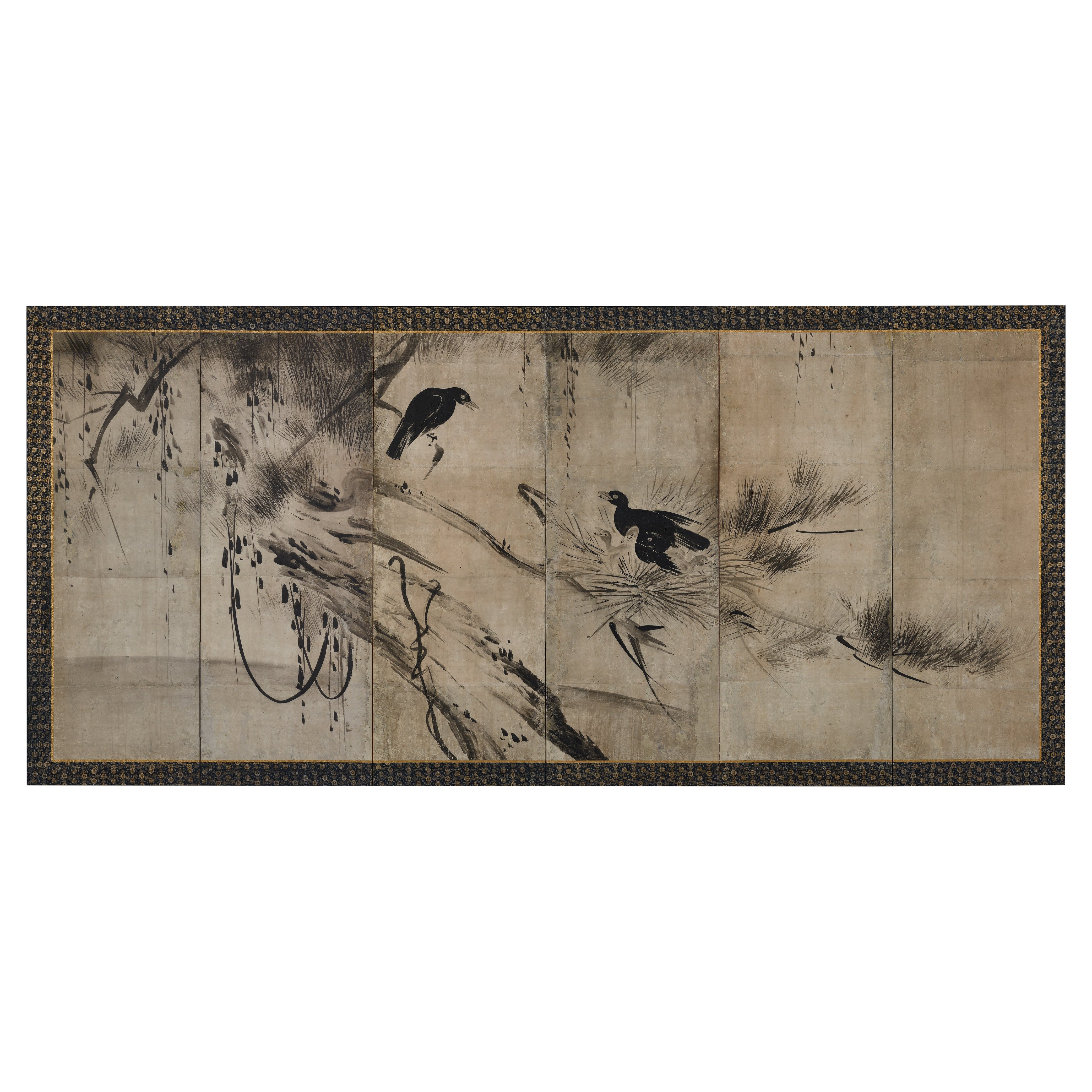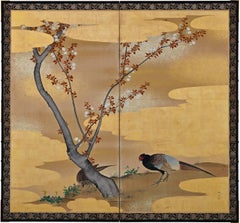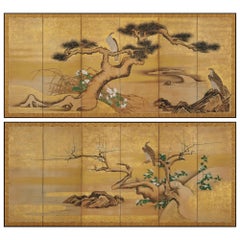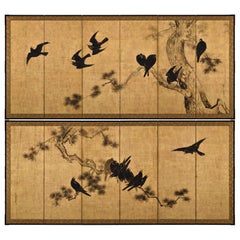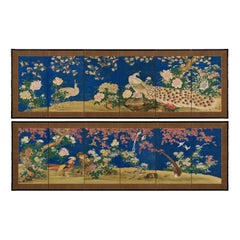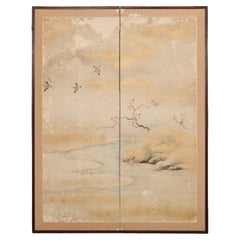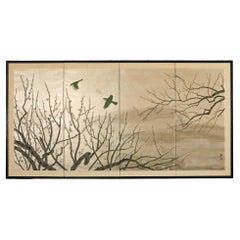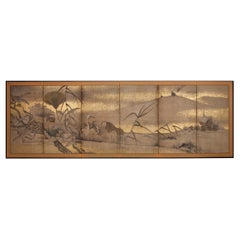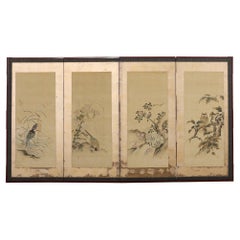Items Similar to 17th Century Japanese Screen. Ink Plum Tree & Birds by Kano Naonobu.
Want more images or videos?
Request additional images or videos from the seller
1 of 7
17th Century Japanese Screen. Ink Plum Tree & Birds by Kano Naonobu.
$38,000
£28,854.30
€32,997.05
CA$53,091.51
A$59,049.35
CHF 30,833.74
MX$718,567.76
NOK 393,793.85
SEK 369,309.16
DKK 246,269.61
Shipping
Retrieving quote...The 1stDibs Promise:
Authenticity Guarantee,
Money-Back Guarantee,
24-Hour Cancellation
About the Item
Kano Naonobu (1607-1650)
Plum Tree and Birds
Six-fold Japanese Screen. Ink and slight color on paper.
In this evocative ink work spread over a six-panel folding screen, we see the consummation of the elegance and refinement of the Edo Kano school. This 17th century screen is a rare surviving example of a large-scale bird and flower painting by Kano Naonobu, the younger brother of Kano Tanyu. Closely related works are held in the Minneapolis Institute of Arts and the Cleveland Museum of Art. Kano Naonobu was the second son of Kano Takanobu (1571-1618). He was granted an estate in Edo in 1630. He became an official painter for the Shogunate and founder of the influential Kobikicho Kano family. The Kano were the most important family of professional painters in Japanese history. Stretching from the sixteenth to the twentieth century, the House of Kano served as official painters to the imperial and military elite for over four centuries. Naonobu produced a number of prominent commissions for the Shogunate including room partitions in Nagoya Castle. In Kyoto, he helped his brother with paintings for Nijō Castle and the major Pure Land Buddhist temple Chion’in.
His older brother Tanyu was a child prodigy and giant of Japanese art who laid the foundations for the Kano school’s dominance of Japan’s Edo period. Tan'yu made bold use of negative space to create his own unique world of simple elegance which was sensitively in tune with the demands of the era. Tanyu’s influence on his younger brother is undeniable but Naonobu’s delicate and lyrical ink paintings are outstanding. Even during his short lifetime his ink talents were praised over those of his brother. Naonobu seems to have inherited the tendency of painters of the previous era who found beauty in negative space, such as Hasegawa Tohaku and Kaiho Yusho, and to this he added elegance of expression. His works show individualism and originality even within the strict confines of the Kano school of the time, suggesting the form of the subject rather than delineating it. Although the screen presented here is a work of ink painting, the winter world of birds, blossoming plum trees and flowing water expressed by ink bleeding, scratching and stopping is already the realm of abstraction.
- Dimensions:Height: 65 in (165.1 cm)Width: 145 in (368.3 cm)Depth: 0.75 in (1.91 cm)
- Style:Edo (Of the Period)
- Materials and Techniques:
- Place of Origin:
- Period:
- Date of Manufacture:Circa 1640
- Condition:Refinished. Wear consistent with age and use. The screen has recently been completely remounted in Kyoto utilizing traditional craftsmen and techniques.
- Seller Location:Kyoto, JP
- Reference Number:1stDibs: LU2472332487722
About the Seller
5.0
Recognized Seller
These prestigious sellers are industry leaders and represent the highest echelon for item quality and design.
Established in 2001
1stDibs seller since 2016
70 sales on 1stDibs
Typical response time: 6 hours
- ShippingRetrieving quote...Shipping from: Kyoto, Japan
- Return Policy
Authenticity Guarantee
In the unlikely event there’s an issue with an item’s authenticity, contact us within 1 year for a full refund. DetailsMoney-Back Guarantee
If your item is not as described, is damaged in transit, or does not arrive, contact us within 7 days for a full refund. Details24-Hour Cancellation
You have a 24-hour grace period in which to reconsider your purchase, with no questions asked.Vetted Professional Sellers
Our world-class sellers must adhere to strict standards for service and quality, maintaining the integrity of our listings.Price-Match Guarantee
If you find that a seller listed the same item for a lower price elsewhere, we’ll match it.Trusted Global Delivery
Our best-in-class carrier network provides specialized shipping options worldwide, including custom delivery.More From This Seller
View AllEarly 19th Century Japanese Screen. Cherry Blossom & Pheasants by Mori Tetsuzan
Located in Kyoto, JP
Mori Tetsuzan (1775-1841)
Pheasants and Cherry Blossoms
Two-fold Japanese screen. Ink, color, gofun, gold and silver on paper.
A two-fold Japanese bir...
Category
Antique Early 19th Century Japanese Edo Paintings and Screens
Materials
Gold Leaf
17th Century Japanese Screen Pair by Soga Nichokuan, Hawks on Pine & Plum Trees
Located in Kyoto, JP
Hawks on plum and pine
Soga Nichokuan (active circa 1625-1660)
Pair of six-fold screens.
Ink, mineral pigments, gofun, gold and speckled gold l...
Category
Antique 1640s Japanese Edo Paintings and Screens
Materials
Wood, Paper
Mid 18th Century Japanese Screen Pair. Crows & Pines by Unkoku Toshuku.
Located in Kyoto, JP
Unkoku Toshuku (1722-1779)
Crows and Pines
A pair of six-panel Japanese Screens. Ink and gold leaf on paper.
Dimensions: Each Screen: H. 170.5 cm x W. 375 cm
Haha-cho or mynah birds, whose forms resemble crows in artwork, were commonly depicted in Japanese art. These types of paintings were originally modeled on paintings attributed to the 13th century Chinese painter Muqi (Mokkei), whose art was enormously influential in Japan. Crows only became a theme among Japanese artists from the later 1500s onward. They likely were inspired by these imported Chinese paintings of myna birds, which are not native to Japan, substituting the native species of crow instead.
The best known early examples of the depiction of Japanese crows are two Momoyama screen...
Category
Antique Mid-18th Century Japanese Edo Paintings and Screens
Materials
Gold Leaf
Mid 19th Century Japanese Screen Pair. Flowers & Birds of the Four Seasons.
Located in Kyoto, JP
Shioka Sorin (1781-1850)
Flowers & Birds of the Four Seasons
Pair of six-panel Japanese Screens. Ink, gofun and pigments on silk.
Dimensions (each screen): H. 91.5cm x W. 285cm (3...
Category
Antique Mid-19th Century Japanese Edo Paintings and Screens
Materials
Silk
Momoyama period Japanese Screen. Crows on Pine. Studio of Hasegawa Tohaku.
Located in Kyoto, JP
Studio of Hasegawa Tohaku (1539-1610)
“Crows on Pine”
Momoyama period. Early 17th Century.
A six-panel Japanese Screen. Ink on paper.
The early 17th century Momoyama period scree...
Category
Antique Early 17th Century Japanese Medieval Paintings and Screens
Materials
Paper
19th Century Japanese Screen Pair. Flowers & Birds of the Four Seasons
Located in Kyoto, JP
Flowers & Birds of the Four Seasons
Pair of six-fold Japanese Screens. Ink, color, gofun and gold on paper.
Second half of the 19th Centur...
Category
Antique Late 19th Century Japanese Meiji Paintings and Screens
Materials
Wood, Paper
You May Also Like
Japanese Edo Two Panel Screen Meandering Stream with Birds
Located in Rio Vista, CA
Weathered Japanese late 18th century Edo period two-panel byobu screen depicting a meandering stream with sparrows in flight. Crafted with natural ink and color pigments on mulberry ...
Category
Antique 18th Century Japanese Edo Paintings and Screens
Materials
Brass
Japanese Showa Four Panel Screen Prunus with Songbirds
Located in Rio Vista, CA
Spectacular late 20th century Japanese Showa period four panel byobu screen depicting blossoming spring prunus or plum trees with songbirds in flight. The screen features a dramatic ...
Category
20th Century Japanese Showa Paintings and Screens
Materials
Brass
Japanese Six Panel Screen, Egrets in Water Landscape with Lotus and Loquats
Located in Hudson, NY
Hasegawa School painting in ink and gold dust accents on mulberry paper.
Category
Antique Mid-19th Century Japanese Paintings and Screens
Materials
Gold
Japanese Kano School Four Panel Screen Birds and Owl
Located in Rio Vista, CA
Amazing 19th century Japanese Meiji period four-panel byobu screen featuring painted panels depicting egrets, heron, pheasants, songbirds, and an owl. Painted with ink and natural co...
Category
Antique 19th Century Japanese Meiji Paintings and Screens
Materials
Gold Leaf
Edo Period Nature Screen by Kanō Tsunenobu (2/2)
Located in Fukuoka, JP
Embark on a journey through the tranquil beauty of a Japanese screen from the Edo period, crafted by the illustrious Kanō Tsunenobu, a master of the Kanō school and nephew to Kanō Ta...
Category
Antique 18th Century Japanese Edo Paintings and Screens
Materials
Paper
Japanese Nihonga Painting 20th Showa/Taisho Scroll Pine Tree and Bird
Located in Amsterdam, Noord Holland
Hanging scroll "Wakamatsu" silk version, painted, signed in box
size Axis: Height 208.5cm Width 49.5cm
Drawing: Height 123cm Width 36cm *There may be slight differences in dimension...
Category
20th Century Taisho Paintings
Materials
Silk
$1,723 Sale Price
20% Off
More Ways To Browse
Antique Bird Tree
Room Partition
Plum Wood
Asian Bird Paintings
Japanese Wood Temple
Japanese Edo Period Screens
Japanese Screens Flowers
Japanese Screen Tree
Japanese Screen Kyoto
Painted Panel Screen Birds
Japanese Antique Wood Birds
Antique Asian Folding Screen
Kano School
Kyoto Screens
17th Century Japanese Paintings
Japanese Screen With Birds
Japanese Kano Screen
Birds Folding Screen
